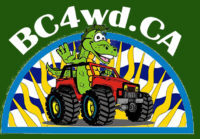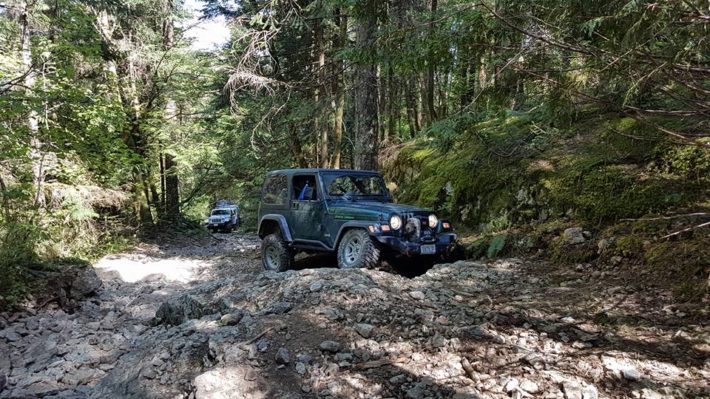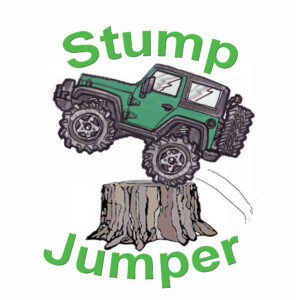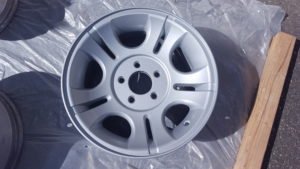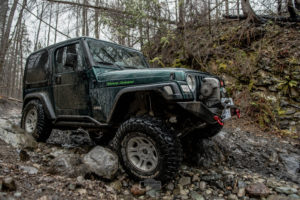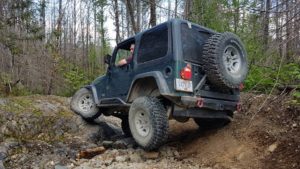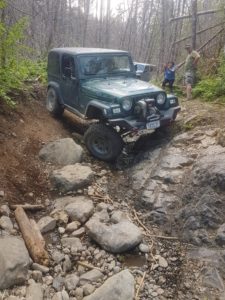There is always a "Bigger is Better" attitude in the world of 4x4s, and as the extreme rigs get crazier there is a tendency for people to think that the minimum standard needed for a wheeling rig has gone up as well. 20 years ago most modified rigs were on 33" tires, and those rigs drove most trails. Sure there are a few hard-core trail that need larger tires, but most don't. Despite what the keyboard jockeys will tell you, spending thousands of dollars on a big lift, lockers, and 35" or larger tires simply isn't necessary for most people.
"Stump Jumper" is my 1997 Jeep TJ. It was built on a very tight budget so most of the parts are used, and the focus is on what is really needed, not what is flashy or trendy.
Under the hood "Stumpy" has the 4 Liter straight six engine and an auto transmission. The straight six has a glorious amount of low-end torque, and the auto lets me focus on driving rather than what gear I am in.
In the rear the Dana 35 Rear axle has been trussed to prevent housing flex from damaging the gears or c-clips, and a set of Yukon Gear chromoly shafts that I got used give it strength similar to a Dana 44. The Dana 30 front axle is strong enough for 33s if you don't abuse it. Both axles were pulled from a 4 cylinder TJ to get 3.73 gears instead of the stock 3.07 gearing. Total spent on axles $550.
The wheels are 15x7 Ford Ranger wheels. The Ranger wheels have 1/2" less backspacing than Jeep wheels so the tires are moved outward slightly for better turning, and the 7" width helps keep the lip of the wheels away from the rocks. I bought them from a wrecker looking like junk, stripped the old finish using oven cleaner from the dollar store, then sanded, primed and painted them. A good etching primer is the key to painting aluminum wheels.
Tires are 33x10.5" BFG KM2s.
The 10.5" width is perfect for lightly modified rigs, as the narrow width (33s are usually 12.5" wide) mean they fit under the stock fenders and don't require wide wheels. The tires are one of the few things I bought new but for my last rig I found used tires and wheels for $600.
The 2.5" lift is a mix of Zone Offroad shocks, some random front coils, and rear coils from a 4 door Jeep JK. All used parts, total spent $50. My springs were sagged and needed replacing, but as long as your stock springs are in good shape there is nothing wrong with good quality coil spacers. Its the shocks that are the most important, as they dictate your wheel travel. For small lifts the factory control arms do just fine.
The Side bars and bumpers came with the Jeep when I bought it. I believe the bars and rear bumper are from Smittybuilt (not great, but affordable). I think the front bumper is home made, and I modified it quite a bit after I got it.
The winch is a Warn 8274. Technically it's an 8000lb winch but given enough amperage it will easily outpull 10,000 lb winches, and it will do pull after pull without overheating. Even after changing to synthetic rope and putting a new solenoid pack on it I had spent less than $500 after selling the wire rope and fairlead it came with.
An engine skid plate and gas tank skid were built by Flex-it fabrication in Chilliwack. They custom made the parts cheaper than I could buy mass produced ones. $500 spent
To communicate on the trails I bought a hand-held Baufeng VHF (HAM) radio for $40 and got my licence by challenging the test through a local radio club.
A used high-lift jack was $50, a recovery strap was $40, and I won a tow strap at a club raffle.
A basic air compressor from Ebay was $50.
$75 spent for a first aid kit, fire extinguisher, and an overnight survival pack completed my basic gear.
All told I spent about $3,000 on modifications to Stump Jumper. Used TJs can be found for as low as $5000 for one with the 4 Liter engine, and even less if you are willing to put up with the 4 cylinder (OK off road but sucky on the highway), so for 8 to 10 thousand dollars (allow some cash for repairs - any used vehicle will need something) you can have a rig that will take you to all the most popular destinations in the province.....once you learn to drive it to it's full potential.
